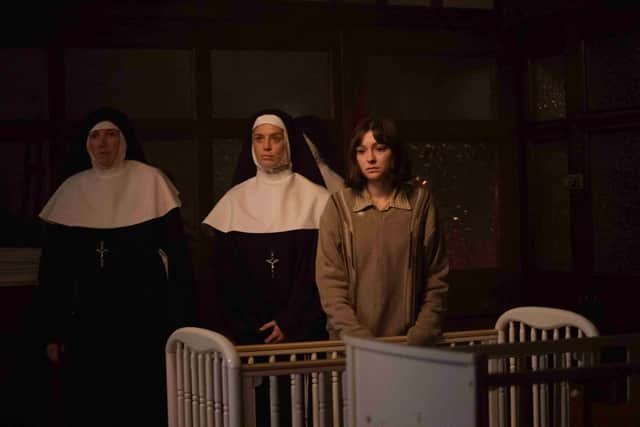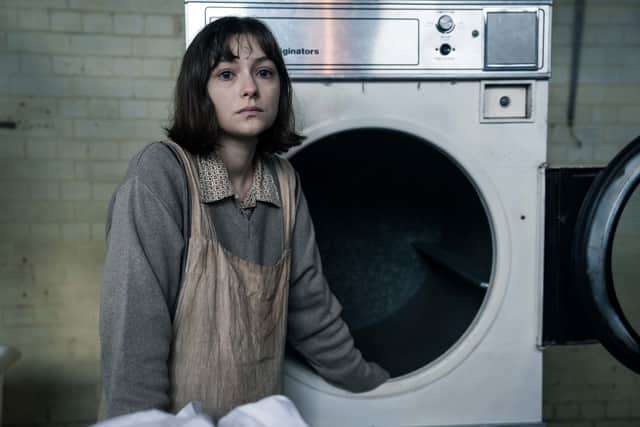The Woman in the Wall: what were Ireland’s Magdalene Laundries, is BBC thriller based on a true story
and live on Freeview channel 276
The Woman in the Wall is a new BBC One drama starring Simon Delaney and Ruth Wilson which premieres this weekend.
The six-part series follows Lorna Brady, an Irish woman who wakes up one morning to find a corpse in her house with no idea who the dead woman is or how she got there.
Advertisement
Hide AdAdvertisement
Hide AdLorna has a history of extreme bouts of sleepwalking, and suffers serious trauma following her time spent in one of Ireland’s institutions for ‘fallen women’.
The series is inspired by a dark and shockingly recent part of Ireland’s history which saw women and girls confined to institutions against their will because of their perceived immorality, among other seemingly random factors.


Is The Woman in the Wall a true story?
The series is not a true story, as the main character, Lorna, is fictional. The Woman in the Wall was created and written by Joe Murtagh who has previously worked as a writer on American Animals, Calm with Horses, and Gangs of London.
However, the show is partly inspired by real events which took place in Ireland for hundreds of years.
Advertisement
Hide AdAdvertisement
Hide AdThe series focuses on Lorna Brady, an Irish woman and unmarried mother in the 20th century who had previously been detained in Ireland’s infamous Magdalene Laundry.
Throughout the show she has flashbacks to her traumatic time detained at one of the laundries, where she was subject to physical and psychological abuse at the Kilkinure Laundry.
Whilst the town of Kilkinure is fictional, the Magdalene Laundries were sadly all too real, and were rife with abuse.
What were the Magdalene Laundries?
The Magdalene Laundries, also known as the Magdalene Asylums were institutions in Ireland established in the 18th century for ‘fallen women’. This essentially meant women who had been involved in prostitution, or had a child outside of marriage, something looked upon very unfavourably by the strict Catholic society of the time.
Advertisement
Hide AdAdvertisement
Hide AdHowever, those confined also included children of unmarried women and victims of sexual abuse.
Despite being remembered as a dark part of Ireland’s history, similar institutions also existed in England, Scotland, and Wales.


The institutions in Ireland were managed by members of the Catholic Church and were a part of Irish life for almost two centuries, before and following Independence from Britain. The last of the institutions did not close until 1996.
It is estimated that 30,00 women and girls were detained in the laundries in total over their history, and many were subjected to abuse.
Advertisement
Hide AdAdvertisement
Hide AdDetainees experienced forced labour - often laundry and needlework, hence the institution’s name - were forcefully isolated from the outside world, and in some cases were beaten by their religious ‘guardians’.
The facilities were also dehumanising, as those inside had their hair cut off and were given new names.
Women and girls entered the laundries by a variety of means - they could be sent there by local authorities, social workers, and members of the church, and it could also function as an alternative to prison or reformatory schools. Once at the laundries, they would be prisoners in all but name, locked in their rooms with barred windows, and on average women and girls spent 27 weeks detained.
The laundries were the subject of the 2002 drama film The Magdalene Sisters starring Eileen Walsh, Dorothy Duffy, Nora-Jane Noone, and Anne-Marie Duff.
Advertisement
Hide AdAdvertisement
Hide AdIn 2013, Ireland's Taoiseach Enda Kenny issued a formal apology for the Magdalene Laundries, calling them the 'nation's shame'.
When is The Woman in the Wall on TV?
The first episode of The Woman in the Wall will air on BBC One at 9.05pm on Sunday 27 August. The next episode will air on Monday 28 at 9pm and the third episode will be on Sunday 3 September at 9pm.
There are six episodes in the series and the date and time of the final three episodes will be confirmed soon. Episodes will also be available to watch on BBC iPlayer after they have first aired.
Comment Guidelines
National World encourages reader discussion on our stories. User feedback, insights and back-and-forth exchanges add a rich layer of context to reporting. Please review our Community Guidelines before commenting.
